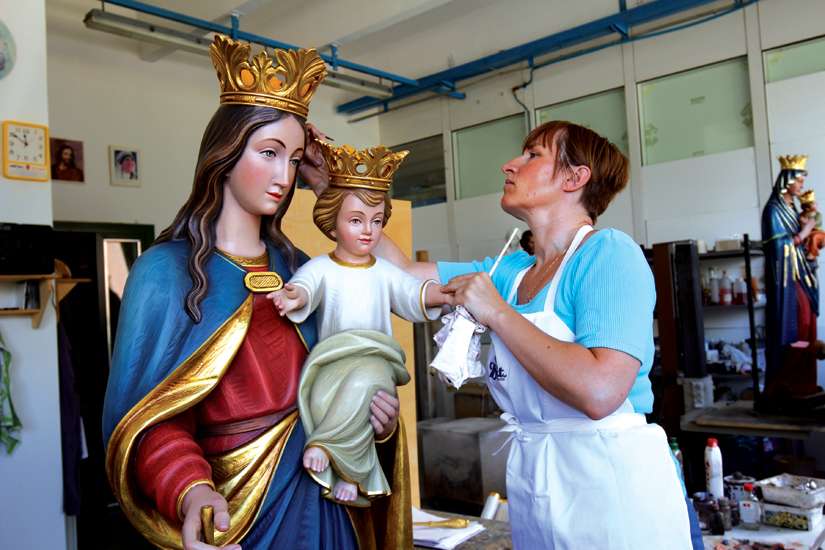Visitors will need repeat visits to properly appreciate the interior statues, given there are 13 new and 26 restored pieces. Among the most prominent are three archangels overlooking the Cardinal’s chair. The 45 kg, 1.5-metre high Gothic statues gleam with gold and silver leafing. Due to their pride of place in the cathedral, the leafing was wrapped all the way around each archangel, even if viewers will never see the back.
At the outset of the project, Fr. Busch presented his vision to Sal Di Carlo, co-founder of the family owned and operated Di Carlo Group, Toronto-based specialists in religious supplies. Together they travelled to Val Gardena in northern Italy, where the woodcarving tradition dates back to the 16th century. There they commissioned the renowned Demetz Art Studio to design and construct new statues, made from wood, limestone, bronze and fibreglass. The fourth-generation family artisans were also tasked with restoring existing statues. Meanwhile, back in Canada, a 10-tonne block of marble glistened in the Mississauga workshop of Traditional Cut Stone. Fr. Busch commissioned stone carver Lawrence Voaides to create a Pietà statue to reside in the Cathedral Crypt. Unlike many interpretations, Voaides’ design incorporates all three Mary’s present at Christ’s crucifixion. Each woman represents a different emotion. From the left, St. Mary Magdalene looks with love at the body of Jesus. In the middle, the Virgin Mary peers heavenward in hope as she places one hand on her son’s heart and the other on her own. On the right, St. Mary Clopas directs her sorrowful gaze at the viewer.
“You can imagine her screaming, ‘What have you done?’” said Voaides, describing the latter Mary. “Her face and expression will raise a lot of questions.” Conspicuously, the figure of Jesus lacks the wounds inflicted in His side, hands and feet. Voaides instead establishes the brokenness of His body in the dramatic angles of His torso and limbs.
“If you pass that block of marble and you don’t feel anything, my work was not done properly,” said Voaides. “A piece of art makes you feel something.”
Although the Pietà was carved locally, it also has roots in Italy. The statue was chiseled out of Carrara marble — the same material Michelangelo used to craft the famous Pietà residing in St. Peter’s Basilica. The prized stone is characterized by tiny crystal particles that lend it a shimmering, almost translucent appearance.
Voaides flew to Tuscany to personally select the slab of marble he would use. His Pietà was sculpted entirely by hand, eschewing the mechanical processes that facilitate most stone work today.
Voaides takes pride in passing this traditional method to the next generation of sculptors. These include his son David, who assisted with the Pietà.
Working with a single block of marble, the sculptor shudders when asked about the risk of making an irreversible mistake.
“Don’t go there!” he said with a smile. “You need to take your time. We don’t have a chance to fix it.”
Like Voaides, Di Carlo speaks about this “once in a lifetime” project in distinctly reverent tones, cognizant the new statues will accompany Toronto’s Catholic faithful for centuries to come. Both the Voaides and Di Carlo families are leaving a multi-generational mark, etched literally in stone. One statue resonates particularly strongly with the Di Carlo’s. In memory of Sal’s deceased mother, the family donated a 1.5-metre representation of the Holy Spirit that hovers above the sanctuary.
“We joke that somewhere down in the fourth generation, it will come down for some restoration work,” said Di Carlo. “And my great, great, great grandson will be doing that work.”





























